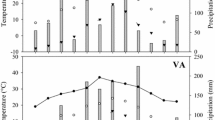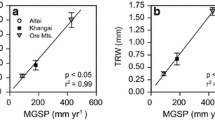Abstract
Water relations and gas exchange were studied in the crowns of small European larch (Larix decidua Mill.) trees with respect to branch position. The upper-crown branches showed significantly higher branch sap flux rate (F la) and branch conductance (g b) compared to the lower crown (P<0.001). Values of leaf conductance (g l), transpiration rate (E) and net photosynthesis (A), averaged for different ranges of atmospheric vapour pressure deficit (VPD), were also higher in the upper crown position. We suppose that the up to 2.6-fold smaller soil-to-leaf hydraulic conductance observed in the lower branches (P<0.001, compared to upper branches) could contribute to the decreased values of F la, g b, g l, and E in the lower crown position. Variation in tracheid lumen diameter with respect to crown position (P<0.001) supported the hypothesis that branches growing at the crown base are hydraulically more constrained than branches located at the top of the tree. Leaf area to sapwood area ratio (A la/A sa) exhibited 1.4 times smaller values in lower crown (P<0.01), however, this could not compensate the effect of decreased hydraulic conductivity of the lower-crown branches.




Similar content being viewed by others
References
Addington RN, Mitchell RJ, Oren R, Donovan LA (2004) Stomatal sensitivity to vapour pressure deficit and its relationship to hydraulic conductance in Pinus palustris. Tree Physiol 24:561–569
Barnard HR, Ryan MG (2003) A test of the hydraulic limitation hypothesis in fast-growing Eucalyptus saligna. Plant Cell Environ 26:1235–1245
Bond BJ, Farnsworth BT, Coulombe RA, Winner WE (1999) Foliage physiology and biochemistry in response to light gradients in conifers with varying shade tolerance. Oecologia 120:183–192
Brodribb TJ, Field TS (2000) Stem hydraulic supply is linked to leaf photosynthetic capacity: evidence from New Caledonian and Tasmanian rainforests. Plant Cell Environ 23:1381–1388
Brodribb TJ, Holbrook NM, Gutierrez MV (2002) Hydraulic and photosynthetic co-ordination in seasonally dry tropical forest trees. Plant Cell Environ 25:1435–1444
Brodribb TJ, Holbrook NM, Zwieniecki MA, Palma B (2005) Leaf hydraulic capacity in ferns, conifers and angiosperms: impacts on photosynthetic maxima. New Phytol 165:839–846
Cochard H, Peiffer M, Le Gall K, Granier A (1997) Developmental control of xylem hydraulic resistances and vulnerability to embolism in Fraxinus excelsior L.: impacts on water relations. J Exp Bot 48:655–663
Cochard H, Lemoine D, Dreyer E (1999) The effects of acclimation to sunlight on the xylem vulnerability to embolism in Fagus sylvatica L. Plant Cell Environ 22:101–108
Cruiziat P, Cochard H, Ameglio T (2002) Hydraulic architecture of trees: main concepts and results. Ann For Sci 59:723–752
Ewers FW, Zimmermann MH (1984a) The hydraulic architecture of eastern hemlock (Tsuga canadensis). Can J Bot 62:940–946
Ewers FW, Zimmermann MH (1984b) The hydraulic architecture of balsam fir (Abies balsamea). Physiol Plant 60:453–458
Gao Q, Zhao P, Zeng X, Cai X, Shen W (2002) A model of stomatal conductance to quantify the relationship between leaf transpiration, microclimate and soil water stress. Plant Cell Environ 25:1373–1381
Gartner BL (1995) Patterns of xylem variation within a tree and their hydraulic and mechanical consequences. In: Gartner BL (ed) Plant stems: Physiological and functional morphology. Academic Press, San Diego, pp 125–149
Grime VL, Sinclair FL (1999) Sources of error in stem heat balance sap flow measurements. Agric For Meteorol 94:103–121
Hubbard RM, Bond BJ, Ryan MG (1999) Evidence that hydraulic conductance limits photosynthesis in old Pinus ponderosa trees. Tree Physiol 19:165–172
Hubbard RM, Ryan MG, Stiller V, Sperry JS (2001) Stomatal conductance and photosynthesis vary linearly with plant hydraulic conductance in ponderosa pine. Plant Cell Environ 24:113–121
Hubbard RM, Bond BJ, Senock RS, Ryan MG (2002) Effects of branch height on leaf gas exchange, branch hydraulic conductance and branch sap flux in open-grown ponderosa pine. Tree Physiol 22:575–581
Jerez M, Dean TJ, Roberts SD, Evans DL (2004) Patterns of branch permeability with crown depth among loblolly pine families differing in growth rate and crown size. Trees 18:145–150
Kikuta SB, Lo Gullo MA, Nardini A, Richter H, Salleo S (1997) Ultrasound acoustic emissions from dehydrating leaves of deciduous and evergreen trees. Plant Cell Environ 20:1381–1390
Köstner B, Falge E, Tenhunen JD (2002) Age-related effects on leaf area/sapwood area relationship, canopy transpiration and carbon gain of Norway spruce stands (Picea abies) in the Fichtelgebirge, Germany. Tree Physiol 22:567–574
Lemoine D, Cochard H, Granier A (2002) Within crown variation in hydraulic architecture in beech (Fagus sylvatica L): evidence for stomatal control of xylem embolism. Ann For Sci 59:19–27
Mäkinen H (2002) Effect of stand density on the branch development of silver birch (Betula pendula Roth) in central Finland. Trees 16:346–353
Margolis H, Oren R, Whitehead D, Kaufmann MR (1995) Leaf area dynamics of conifer forests. In: Smith WK, Hinckley TM (eds) Ecophysiology of Coniferous Forests. Academic Press, San Diego, pp 181–223
Mayr S, Rothart B, Dämon B (2003) Hydraulic efficiency and safety of leader shoots and twigs in Norway spruce growing at the alpine timberline. J Exp Bot 54:2563–2568
McDowell NG, Phillips N, Lunch C, Bond BJ, Ryan MG (2002a) An investigation of hydraulic limitation and compensation in large, old Douglas-fir trees. Tree Physiol 22:763–774
McDowell N, Barnard H, Bond BJ, Hinckley T, Hubbard RM, Ishii H, Köstner B, Magani F, Marshall JD, Meinzer FC, Phillips N, Ryan MG, Whitehead D (2002b) The relationship between tree height and leaf area: sapwood area ratio. Oecologia 132:12–20
Medhurst JL, Beadle CL (2002) Sapwood hydraulic conductivity and leaf area—sapwood area relationships following thinning of a Eucalyptus nitens plantation. Plant Cell Environ 25:1011–1019
Meinzer FC (2003) Functional convergence in plant responses to the environment. Oecologia 134:1–11
Mencuccini M, Grace J (1994) Climate influences the leaf area/sapwood area ratio in Scots pine. Tree Physiol 15:1–10
Mencuccini M, Grace J (1996) Developmental patterns of aboveground xylem conductance in a Scots pine (Pinus sylvestris L.) age sequence. Plant Cell Environ 19:939–948
Mokany K, McMurtrie RE, Atwell BJ, Keith H (2003) Interaction between sapwood and foliage area in alpine ash (Eucalyptus delegatensis) trees of different heights. Tree Physiol 23:949–958
Monteith JL, Unsworth MH (1990) Principles of environmental physics. Edward Arnold, London
Niinemets Ü, Kull O, Tenhunen JD (1998) An analysis of light effects on foliar morphology, physiology, and light interception in temperate deciduous woody species of contrasting shade tolerance. Tree Physiol 18:681–696
Nobel PS (1999) Physicochemical and Environmental Plant Physiology. Academic Press, San Diego
Phillips N, Oren R (1998) A comparison of daily representations of canopy conductance based on two conditional time-averaging methods and the dependence of daily conductance on environmental factors. Ann For Sci 55:217–235
Phillips N, Bond BJ, McDowell NG, Ryan MG, Schauer A (2003) Leaf area compounds height-related hydraulic costs of water transport in Oregon White Oak trees. Funct Ecol 17:832–840
Protz CG, Silins U, Lieffers VJ (2000) Reduction in branch sapwood hydraulic permeability as a factor limiting survival of lower branches of lodgepole pine. Can J For Res 30:1088–1095
Rijkers T, Pons TL, Bongers F (2000) The effect of tree height and light availability on photosynthetic leaf traits of four neotropical species differing in shade tolerance. Funct Ecol 14:77–86
Ryan MG, Yoder BJ (1997) Hydraulic limits to tree height and tree growth. BioScience 47:235–242
Sakuratani T (1981) A heat balance method for measuring water flux in the stem of intact plants. J Agric Meteorol 37:9–17
Salleo S, Nardini A, Pitt F, Lo Gullo MA (2000) Xylem cavitation and hydraulic control of stomatal conductance in Laurel (Laurus nobilis L.). Plant Cell Environ 23:71–79
Santiago LS, Goldstein G, Meinzer FC, Fisher JB, Machado K, Woodruff D, Jones T (2004) Leaf photosynthetic traits scale with hydraulic conductivity and wood density in Panamanian forest canopy trees. Oecologia 140:543–550
Schäfer KVR, Oren R, Tenhunen JD (2000) The effect of tree height on crown level stomatal conductance. Plant Cell Environ 23:365–375
Sellin A, Kupper P (2004) Within-crown variation in leaf conductance of Norway spruce: effects of irradiance, vapour pressure deficit, leaf water status and plant hydraulic constraints. Ann For Sci 61:419–429
Sellin A, Kupper P (2005a) Effects of light availability versus hydraulic constraints on stomatal responses within a crown of silver birch. Oecologia 142:388–397
Sellin A, Kupper P (2005b) Variation in leaf conductance of silver birch: effects of irradiance, vapour pressure deficit, leaf water status and position within a crown. For Ecol Manage 206:153–166
Sperry JS, Nichols KL, Sullivan JEM, Eastlack SE (1994) Xylem embolism in ring-porous, diffuse-porous, and coniferous trees of Northern Utah and Interior Alaska. Ecology 75:1736–1752
Tyree MT, Ewers FW (1991) The hydraulic architecture of trees and other woody plants. New Phytol 119:345–360
Tyree MT, Zimmermann MH (2002) Xylem Structure and the Ascent of Sap. Springer, Berlin Heidelberg New York
White D, Beadle C, Worledge D, Honeysett J, Cherry M (1998) The influence of drought on the relationship between leaf and conducting sapwood area in Eucalyptus globulus and Eucalyptus nitens. Trees 12:406–414
Whitehead D (1998) Regulation of stomatal conductance and transpiration in forest canopies. Tree Physiol 18:633–644
Acknowledgements
We are grateful to Mr. Dennis Otieno, Mrs. Tiiu Kupper and Ms. Olimpia Kolcun for their assistance and support in the field. We would like to thank the staff of the Berchtesgaden National Park for providing suitable working conditions. We are also grateful to three anonymous reviewers for their critical remarks and useful comments on the manuscript. This study was supported by grant No. 5296 from the Estonian Science Foundation and by the German Academic Exchange Service (DAAD)
Author information
Authors and Affiliations
Corresponding author
Rights and permissions
About this article
Cite this article
Kupper, P., Sellin, A., Tenhunen, J. et al. Effects of branch position on water relations and gas exchange of European larch trees in an alpine community. Trees 20, 265–272 (2006). https://doi.org/10.1007/s00468-005-0033-3
Received:
Accepted:
Published:
Issue Date:
DOI: https://doi.org/10.1007/s00468-005-0033-3




